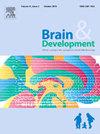Characteristics of neonatal-onset and presumed neonatal arterial ischemic stroke
IF 1.4
4区 医学
Q4 CLINICAL NEUROLOGY
引用次数: 0
Abstract
Objective
To clarify the difference in clinical-radiological features between neonatal-onset arterial ischemic stroke (AIS) and presumed neonatal AIS with a normal neonatal neurological history.
Methods
Twenty-one neonatal AIS patients and seven with presumed neonatal AIS were identified in Aichi Prefecture, Japan, between 2010 and 2014. MRI and clinical characteristics were determined.
Results
Nine patients (43 %) with neonatal AIS and only one patient (13 %) with presumed neonatal AIS underwent emergency cesarean sections (ECS). Pyramidal tract involvement was more common in patients with presumed neonatal AIS (71 %) than in those with neonatal AIS (24 %). The most common sequela, hemiplegia, was present in 33 % of patients with neonatal AIS and 71 % with presumed neonatal AIS.
Conclusions
The small number of ECS in presumed neonatal AIS suggests different causal factors from those of neonatal AIS. Given the different distributions of lesions and sequelae, there can be undiagnosed patients with presumed neonatal AIS and no sequelae.
新生儿起病和推定新生儿动脉缺血性脑卒中的特点
目的 明确新生儿发病的动脉缺血性卒中(AIS)与新生儿神经系统病史正常的推测新生儿 AIS 在临床放射学特征上的差异。方法 2010 年至 2014 年间在日本爱知县发现了 21 例新生儿 AIS 患者和 7 例推测新生儿 AIS 患者。结果9例新生儿AIS患者(43%)和1例推测新生儿AIS患者(13%)接受了紧急剖宫产手术(ECS)。推测新生儿 AIS 患者锥体束受累的比例(71%)高于新生儿 AIS 患者(24%)。最常见的后遗症是偏瘫,在新生儿 AIS 患者中占 33%,在推测的新生儿 AIS 患者中占 71%。鉴于病变和后遗症的分布不同,可能存在未被诊断的推定新生儿 AIS 患者,但却没有后遗症。
本文章由计算机程序翻译,如有差异,请以英文原文为准。
求助全文
约1分钟内获得全文
求助全文
来源期刊

Brain & Development
医学-临床神经学
CiteScore
3.60
自引率
0.00%
发文量
153
审稿时长
50 days
期刊介绍:
Brain and Development (ISSN 0387-7604) is the Official Journal of the Japanese Society of Child Neurology, and is aimed to promote clinical child neurology and developmental neuroscience.
The journal is devoted to publishing Review Articles, Full Length Original Papers, Case Reports and Letters to the Editor in the field of Child Neurology and related sciences. Proceedings of meetings, and professional announcements will be published at the Editor''s discretion. Letters concerning articles published in Brain and Development and other relevant issues are also welcome.
 求助内容:
求助内容: 应助结果提醒方式:
应助结果提醒方式:


